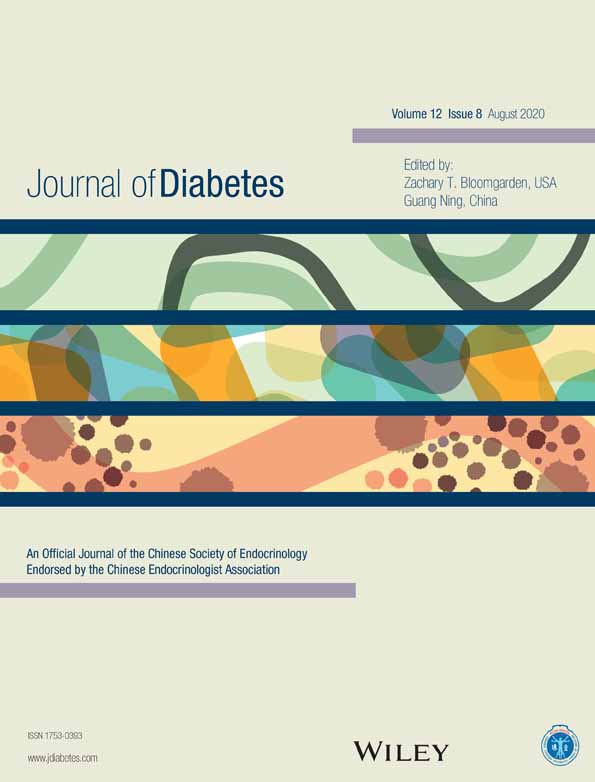Detection of diabetes and prediabetes using glycosylated hemoglobin in Chinese adults living in Shanghai: A prospective analysis
使用糖化血红蛋白诊断中国上海成人糖尿病和糖尿病前期:一项前瞻性分析
Funding information: the “Outstanding Young Talent Program” from Shanghai Municipal Government; the “Shanghai Outstanding Academic Leader Program”; the Clinical Research Program from the Ruijin Hospital, Grant/Award Number: 2018CR002; the Clinical Research Program from the Shanghai Jiaotong University School of Medicine, Grant/Award Number: DLY201801; the National Basic Research Program of China (973 Program), Grant/Award Number: 2015CB553601; the National Key R&D Program of China, Grant/Award Numbers: 2016YFC0901200, 2016YFC1304904, 2016YFC1305202, 2016YFC1305600, 2017YFC1310700, 2018YFC1311800; the National Natural Science Foundation of China, Grant/Award Numbers: 81561128019, 81621061, 81622011, 81870560; the Technology Innovation Program from the Shanghai Municipal Government, Grant/Award Number: 18411951800
Abstract
enBackground
This study aimed to evaluate the discriminative abilities of glycosylated hemoglobin (HbA1c) and to examine the optimal HbA1c cutoff values for diabetes and prediabetes in Chinese adults.
Methods
Data of a population-based cohort of Chinese adults aged ≥40 years living in Jiading District in Shanghai were used. At baseline, 9389 and 7241 participants were included to identify the optimal HbA1c cutoff values for diabetes and prediabetes, respectively using the 1999 World Health Organization criteria as reference. In addition, the follow-up data on incident diabetes of 4538 participants were used to determine the HbA1c cutoff value for prediabetes using the development of diabetes as reference. The discriminative abilities of HbA1c were evaluated using receiver operating characteristic (ROC) curves, and the optimal cutoff values were determined by Youden's index.
Results
The areas under the ROC curves were 0.849 for diabetes, 0.614 for prediabetes using baseline data, and 0.648 for prediabetes using follow-up data. An HbA1c cutoff value of 6.0% had the largest Youden's index to diagnose diabetes with a sensitivity of 70.2% and a specificity of 87.4%. An HbA1c cutoff value of 5.6% was indicated for prediabetes using both baseline and follow-up data. However, the sensitivity and specificity were both low (55.4% and 61.1% using an oral glucose tolerance test as reference, 64.6% and 57.1% using incident diabetes as reference).
Conclusions
An HbA1c value ≥6.0% could be used to detect diabetes in Chinese adults aged ≥40 years. However, although an HbA1c value of 5.6% to 5.9% was indicated in this study, the overall discrimination of HbA1c for prediabetes was poor.
摘要
zh背景
本研究旨在中国成年人群中, 评估糖化血红蛋白 (HbA1c) 诊断糖尿病和糖尿病前期的表现并寻找诊断的最佳HbA1c切点。
方法
研究人群来自上海市嘉定区年龄≥40岁的社区居民。采用基线调查横断面数据, 以1999年世界卫生组织 (WHO) 糖尿病和糖尿病前期定义为参照标准, 分别纳入9389名和7241名研究对象来确定诊断糖尿病和糖尿病前期的最佳HbA1c切点。另外采用随访数据, 以糖尿病发病为参照标准, 纳入4538名研究对象来确定诊断糖尿病前期的最佳HbA1c切点。使用受试者工作特征曲线 (ROC) 评估HbA1c的诊断表现, 并根据约登指数确定最佳诊断切点。
结果
采用基线数据, HbA1c诊断糖尿病的ROC曲线下面积(AUC)为0.849, HbA1c诊断糖尿病前期的AUC为0.614。采用随访数据, HbA1c诊断糖尿病前期的AUC为0.648。HbA1c切点取6.0%时, 诊断糖尿病的约登指数最大, 其敏感性为70.2%, 特异性为87.4%。基线和随访数据均显示, 诊断糖尿病前期的最佳HbA1c切点为5.6%, 但其敏感性和特异性均较低 (采用口服葡萄糖耐量试验为参照标准时,敏感性和特异性分别为55.4%和61.1%;采用随访过程中糖尿病发病作为参照标准时, 敏感性和特异性分别为64.6%和57.1%)。
结论
在年龄≥40岁的中国成年人中, HbA1c≥6.0%可用于诊断糖尿病。然而, 尽管本研究得出糖尿病前期的HbA1c范围为5.6%-5.9%, 但HbA1c对诊断糖尿病前期的效果较差。
CONFLICT OF INTEREST
The authors have no conflict of interest to disclose.




